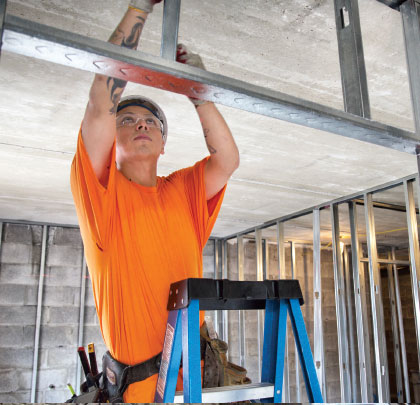The construction industry geared up for Safety Week (May 7–11). Now its fifth year, what began as a joint initiative between the Construction Industry Safety (CIS) group and the Incident and Injury Free (IIF) CEO Forum has spread across the industry, and for good reason.
With roughly 10.3 million workers employed in the construction industry, everyone—workers, employers, families, friends—are affected by safe, or unsafe, actions at the jobsite. According to the Bureau of Labor Statistics, in 2016, the most recent year for which statistics are available, 991 construction workers were killed on the job, accounting for 21.1 percent of worker fatalities across private industries. In addition, 82,760 nonfatal injuries and illnesses involving days away from work were recorded, affecting productivity, quality, and employee morale.
Safety is everyone’s responsibility, and the mission of Safety Week is simple: safety must be communicated and practiced every day, with every action, across every jobsite.
KEEP SAFETY TOP OF MIND
Every choice and decision we make—from the routine to the major—sets the stage for safety. Some choices, such as wearing your seatbelt, checking the webbing of your harness, or remembering your hard hat, may feel second nature, but that doesn’t make them any less important. Some decisions require more effort, like taking the time to conduct a stretch-and-flex, report a jobsite hazard, investigate a near-miss, or prepare for an emergency situation. Each of these examples adds or subtracts from site safety, so how do we empower workers and leaders alike to choose safety every time?
That’s where technology is making a major impact. In the last year, a flood of new construction-specific solutions, investor funding, and digital innovation in the space have come together to solve some of the industry’s most pressing safety challenges.
The Internet of Things (IoT) is enabling real-time communication and data collection via a network of connected devices at the jobsite, providing unprecedented visibility into safety concerns. Wearables, sensors, and drones, among other technology innovations, are connecting workers, supervisors, and executives in new and important ways. And, when combined with data analytics and intelligent software, they’re helping contractors build safer, smarter, and faster.
EMPOWERING THE WORKER
Investing in strong safety tools communicates that an organization values its workers and serves as a daily reminder of their critical role in making safe choices, looking out for one another, and identifying/reporting hazards in real time. Workers are the ones who experience risk on a daily basis, and when they have to clip a wearable device onto their waist belt each morning before they step onto the jobsite, for example, it reinforces a safety mindset and gives them an effective tool to communicate with their supervisors from anywhere on site. In addition, by detecting fall events or periods of worker inactivity and sending location-based notifications to assigned personnel, new technologies provide peace of mind, helping to reduce the lag time between when an incident occurs, when personnel are notified, and when help arrives. When workers feel valued and protected and have tools to complete the task at hand safely, efficiently, and effectively, projects keep moving forward and everyone wins.
With so many competing priorities, it’s impossible for supervisors to see or know what’s happening across an entire site by themselves, and new, IoT-enabled technologies reduce the burden of needing to manually gather and monitor site operations across resources, trades, and subs. Other types of IoT sensors can monitor environmental factors that impact safety, such as air quality, temperature, and humidity. For example, when supervisors can log into a dashboard and easily see an outside temperature of nearly 100-degrees, even when the trailer on the opposite side of the jobsite feels cool, they can require more water breaks and manage their workforce and workflows accordingly.
Drones are also being used to survey and document hard-to-reach hazardous spots and large sites more efficiently and affordably than traditional methods. With a new wealth of visual data, emerging solutions are applying artificial intelligence (AI) and machine learning to scan jobsites, tag objects, and identify safety violations (such as a worker missing gloves). By leveraging these cutting-edge technologies, contractors can have a more complete picture of workers, equipment, and environmental factors on sites. With fewer manual tasks and reduced administrative burden, site supervisors can have the time and information to make better, more informed decisions.
DATA-DRIVEN DECISION MAKING
Harvesting data to inform decision-making is one of the most exciting new technology trends at the jobsite. IoT-enabled solutions are unlocking new safety incident, behavioral, hazard identification, and risk management insights that help improve processes and reduce incidents on the jobsite. With a data-driven understanding of when, where, and how safety incidents are occurring, improved safety training programs and procedures can be developed. What weather conditions result in the most incidents? Which trade is having the most near-misses or incidents? If Wednesday is the most dangerous day for a particular trade, a weekly morning safety stand-down or toolbox talk, for example, can be scheduled for that crew.
STRONGER AND SAFER TOGETHER
Every day presents a new opportunity to further the safety culture on the jobsite, whether it’s choosing to report an unsafe behavior, holding a toolbox talk, or changing processes. New digital technologies are giving construction firms the tools they need to reinforce—and practice—their commitment to safety daily across all functions, departments, and levels of an organization. And, most importantly, the real-time data and actionable insights they provide give everyone—from executives to project leaders and crews—the power to build safer and smarter.
About the Author:
Chad Hollingsworth, CEO of Triax Technologies, cofounded the company to bring effective, innovative technology to challenging environments. Through its flagship Spot-r system, Triax provides real-time visibility into workers, equipment, and safety on site, resulting in increased operational efficiency, faster response to injuries, and overall improved project management. Chad can be reached at chad@triaxtec.com. For more information, visit www.triaxtec.com.
_________________________________________________________________________
Modern Contractor Solutions, June 2018
Did you enjoy this article?
Subscribe to the FREE Digital Edition of Modern Contractor Solutions magazine.



